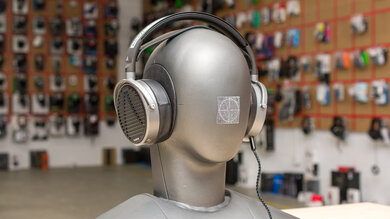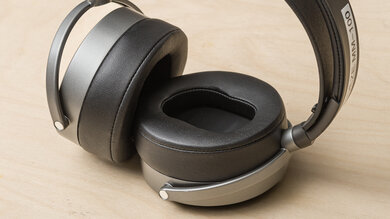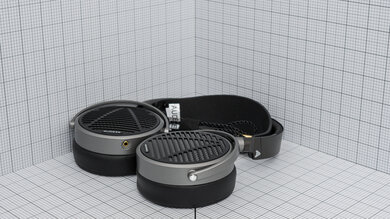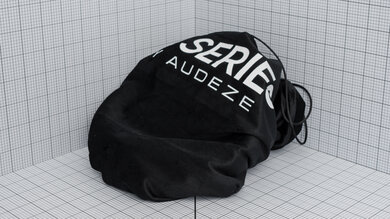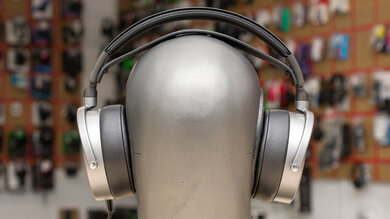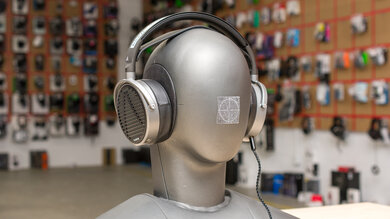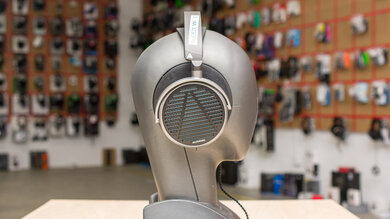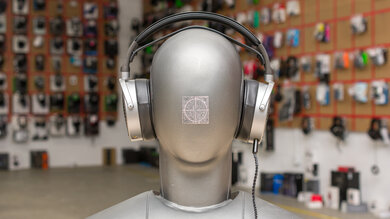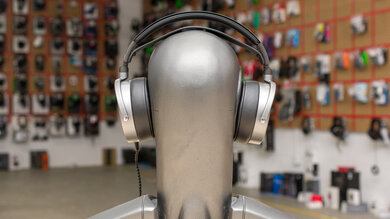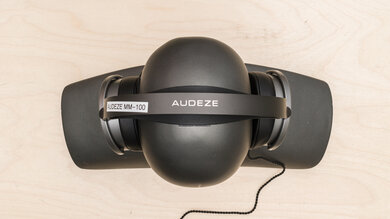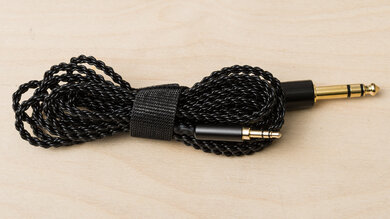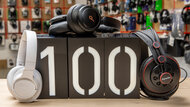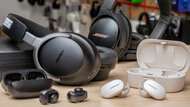The Audeze MM-100 are wired open-back headphones with planar magnetic drivers. They're one of two headphones designed in collaboration with Grammy award-winning engineer/producer Manny Marroquin, intended as a mid-range alternative to the more premium Audeze MM-500. They're designed with studio applications in mind, so they sport gel-filled earpads and an adjustable ski-band-style headband that aims to make long recording sessions as comfortable as possible. Their low sensitivity and impedance also mean you can use them with a phone or laptop without a dedicated amp or sound card to drive them.
Our Verdict
The Audeze MM-100 are disappointing for sports and fitness use as they're not intended for this purpose. Their bulky design is prone to falling off your head during more intense movements, and it's easy to get the audio cable snagged on things while you're in motion. They also lack any controls to change the track or adjust the volume on the fly.
-
Bulky and heavy design.
The Audeze MM-100 are studio headphones that aren't intended for use on the go. As a result, they're a poor choice for travel use as their bulky design means they're not very portable. Their open-back design also provides almost no isolation against external noise, and they leak enough audio for others around you to hear on the bus or train. On the upside, though, they're comfortable and well-built enough to survive long journeys.
-
Comfortable fit and excellent build quality.
-
Bulky and heavy design.
-
Poor noise isolation performance.
The Audeze MM-100 are studio headphones that aren't designed for use in an office setting. While they're comfortable enough to wear at your desk, they provide almost no isolation against external noise, so it's easy to get distracted by office chatter. They also leak a lot of audio, so within the average office setting, others can hear what you're listening to.
-
Comfortable fit and excellent build quality.
-
Bulky and heavy design.
-
Poor noise isolation performance.
-
Leak a lot of audio.
The Audeze MM-100 can only be used wired, so they're not suitable for wireless gaming.
The Audeze MM-100 are passable for wired gaming. They're comfortable enough for extended gaming sessions and provide a low latency performance via their wired connection. Their L/R drivers are well-matched, which makes it easier to identify audio objects, like footsteps, in the stereo field, and their accurate high-bass response helps bring them out further. They lack an integrated mic, so you'll need to purchase a standalone mic or opt for Audeze's boom mic-equipped cable.
-
Comfortable fit and excellent build quality.
-
Poor noise isolation performance.
The Audeze MM-100 are very good when it comes to audio reproduction accuracy. Their frequency response mostly follows their flat sound profile, with a few major peaks and dips. The sound profile is relatively well-aligned with our target in the bass and mid-range, though the treble response is notably recessed and more closely follows the SoundGuys.com Studio Curve. Their L/R drivers are well-balanced when it comes to amplitude, though there are minor deviations in the treble's frequency response and phase. Their group delay is below the audibility threshold across the entire range for a tight bass response. They have a very low harmonic distortion performance, too, even at higher listening levels, so there will be no audible coloration of your audio.
The Audeze MM-100 are terrible at isolating you from your surroundings. Their open-back design allows almost all external noise to filter in to your audio, whether its bass-range sounds, like engine rumble, or the high-pitched whine of a noisy fridge. They also leak a lot of audio, so you won't want to bring them to quiet environments, like the library, where you risk bothering those around you.
The Audeze MM-100 lack a built-in microphone.
The Audeze MM-100 have good frequency response consistency. The headphones' over-ear seal ensures a very similar sound delivery across wearers and sessions. If you wear glasses, the lowest sub-bass frequencies can exhibit a bit less thump, but the performance is still very similar regardless of your head size or hair length.
- 5.7 Sports And Fitness
- 4.5 Travel
- 3.0 Office Work
- 4.3 Wireless Gaming (In Development)
- 6.3 Wired Gaming (In Development)
Performance Usages
- 7.9 Audio Reproduction Accuracy
- 0.8 Noise Isolation
- 0 Microphone (In Development)
- 7.5 Frequency Response Consistency
Changelog
-
Updated Jul 29, 2025:
We've updated the Sound Profile box with a link to a downloadable folder of EQ settings that will help you match these headphones' frequency response to different target curves available in our Graph Tool.
-
Updated Apr 25, 2025:
This review has been updated to Test Bench 2.0, which adds the following tests: Stereo Mismatch, Group Delay, Cumulative Spectral Decay, PRTF, Harmonic Distortion, and Electrical Aspects. We've added new performance usages and updated the text throughout the Sound tests and side-by-sides.
- Updated Apr 25, 2025: We've converted this review to Test Bench 2.0, which updates our sound tests and adds performance usages. You can read more about this in our changelog.
-
Updated Nov 21, 2024:
The following test groups have been updated after Test Bench 1.8: Sound Profile, Raw Frequency Response, Bass Profile: Target Compliance, Mid-Range Profile: Target Compliance, Treble Profile: Target Compliance, and Peaks/Dips. Text changes have also been made throughout the review and to the side-by-sides to match these results.
- Updated Nov 19, 2024: We've converted this review to Test Bench 1.8, which updates our target curve and Sound tests. You can read more about this in our changelog.
Check Price
Differences Between Sizes And Variants
The Audeze MM-100 are available in one color: gunmetal gray with a black headband and black grilles.
Please let us know in the comments if you encounter another variant of these headphones.
Popular Headphones Comparisons
The Audeze MM-100 are wired, open-back headphones designed for studio use and reference listening. Like the Audeze LCD 2 Classic/LC2C, they feature planar magnetic drivers and a rock-solid build quality. They also share a similar sound profile: one that lacks low bass but features balanced mids and a recessed treble range. They're heavy on the head, even compared to other planar magnetic headphones like the HiFiMan Sundara 2020. That said, they're not as heavy as the closed-back Audeze Maxwell Wireless, and the manufacturer has introduced gel-filled earpads with the MM-100 that aim to offset the weight better with a comfortable seal.
If you're looking for more headphones, check out our recommendations for the best studio headphones, the best headphones for music, and the best open-back headphones.
The Audeze MM-100 and the HiFiMan Sundara 2020 are both open-back headphones with planar magnetic drivers. However, the two have quite different sound profiles, with the HiFiMan following our target curve a bit better. They're also slightly more comfortable. That said, the Audeze are considerably better built and more likely to be a durable, long-term option in the studio.
The Audeze MM-100 and the Sennheiser HD 490 PRO are both open-back, over-headphones designed for studio use. They have some differences in design that might cause you to prefer one over the other. The Sennheiser have better bass extension and a less recessed treble range that's useful for identifying clicks and pops during audio editing tasks. The Audeze use planar magnetic drivers, and the Sennheiser use dynamic neodymium magnets and, as a result, the Audeze have a greater degree of pinna activation that can translate to a wider sound. They're also much heavier and less comfortable on the head. The Sennheiser come with two sets of pads, so you can swap them out to alter the sound profile slightly. However, the Audeze have a higher build quality that will translate to better durability in the studio.
The Beyerdynamic DT 990 PRO and the Audeze MM-100 are both wired, open-back audiophile headphones with slightly different strengths. The Audeze are better built using more premium materials, and their planar magnetic drivers allow for more interaction with the pinna, which can help create the impression of space. While both headphones have relatively balanced sound profiles, the Beyerdynamic have a more prominent bass that aligns more with our target. That said, the Beyerdynamic's slightly overemphasized treble can be fatiguing to listen to over long periods, which is less of an issue with the Audeze due to their veiled treble response, though the Audeze can sound too dark for some people's tastes.
The Audeze LCD 2 Classic/LC2C and the Audeze MM-100 are open-back, planar magnetic headphones from the same manufacturer. As a result, they share a lot of similar traits, with little to differentiate between them. They're both comfortable and well-built, with both headphones employing adjustable ski-band style headbands. They also have extremely similar sound profiles, with an underemphasized bass response and a recessed treble range. The main difference between the two is the soundstage, where the LCD 2 Classic sound a touch more wide and open. The LCD 2 Classic also have a higher impedance, and you'll need an amp or soundcard to drive them.
The Audeze MM-100 and the Sennheiser HD 6XX are both open-back, wired headphones designed for audiophiles and music professionals. Choosing between them will depend on personal preference. The Audeze are more comfortable and better built, albeit substantially heavier. Both headphones lack low bass, which is normal for open-back designs, and both excel at reproducing mid-range sounds with clarity and accuracy. However, they differ slightly in their treble amount, where the Sennheiser sound brighter.
Video

We've upgraded our Headphones Test Bench to 2.0! This update brings several key changes to our tests and usages, making it easier than ever to interpret our sound results based on your personal preferences. You'll also find a brand-new interactive graph tool featuring multiple targets (including our own!) for you to explore and compare.
For a full breakdown, check out our changelog, which includes detailed commentary from our test designer explaining the rationale behind our update.
We'd also love to hear your thoughts: your feedback helps us keep improving, so join us in the comments!
Test Results
The Audeze MM-100 have a fairly flat sound profile that's comparable to other open-back headphones equipped with planar magnetic drivers, like the HiFiMan Sundara 2020. Their sound signature somewhat resembles the SoundGuys.com Studio Curve with a recessed low-bass, which is normal for open-back designs, and de-emphasized treble response.
You can download an EQ presets folder to help tweak the headphones' frequency response to more closely resemble target curves in our Graph Tool, but keep in mind that you won't be able to surpass the physical limitations of their enclosure for bass performance.
The frequency response consistency is good. Their treble and bass delivery can vary depending on fit and positioning. If you wear glasses, you'll experience inconsistencies in the bass range as the arms of your glasses can prevent a proper seal from being created. Overall, though, if you take some time to adjust the fit, you'll achieve consistent audio delivery.
The bass compliance with our target is very good. Like most open-back designs, they're not abundant in low bass, and the range as a whole is slightly underemphasized compared to our target. However, the high bass is less underemphasized than the rest of the range and adds warmth to kicks and basslines.
The mid-range compliance is excellent. The response throughout this range is very flat and follows our target curve well, resulting in a clear and accurate reproduction of vocals and lead instruments. There's some slight roll-off at the top of the range that somewhat dulls the upper harmonics of higher-pitched vocals, though. On songs like Marvin Gaye's What's Happening Brother, the strings and rhythm guitar sound smooth and balanced, while the lead vocal sounds forward in the mix.
These headphones have poor compliance with our treble range target. The range as a whole is quite underemphasized, and there's a large dip between the low and mid-treble that dulls the upper harmonics of vocals and reduces the brilliance of sibilants, like cymbals. This extends further into the high-treble. While we lose sensitivity to this range over time, you may notice that acoustic guitars and breathy vocals lack air and brilliance. The underemphasis in this range can help reduce ear fatigue over longer listening sessions.
They have good peaks and dips performance, meaning the frequency response doesn't deviate much from their mostly flat sound profile. A significant dip between the high-mid and low-treble range dulls plucky mid-range instruments like acoustic guitars. A sharp peak in the low-treble range emphasizes the upper harmonics of vocals. It's followed by a significant dip in the mid-treble, which weakens sibilants like crash cymbal hits. While there are some further deviations that continue into the high-treble, we lose sensitivity to this range over time.
These headphones have a great stereo mismatch performance. The L/R drivers are well-matched when it comes to weighted amplitude, with only slight deviations in the treble range. Their weighted frequency response in each driver has a bit of mismatch in the treble range, which can slightly skew the stereo image to either ear, depending on the pitch. They're not quite as well-matched when it comes to phase, but the most notable mismatch occurs in the high-treble, so it's unlikely to be audible in real-life content. These results only apply to our unit, so you may experience different results with a different set.
The Audeze MM-100 have an outstanding group delay performance. Group delay is below the audibility threshold across the entire frequency range, resulting in tight bass and transparent treble reproduction.
The Audeze MM-100 have a decent PRTF performance. While their PRTF measurements indicate that there's some deviation from the way in which an angled reference speaker interacts with your pinna, these open-backs are still capable of producing a sense of depth and width in your audio.
The Audeze MM-100 have an incredible harmonic distortion performance. There's no audible degradation of audio fidelity at both 94 and 104dBSPL, so you don't have to worry about any unintended coloration in your audio.
These headphones don't require an amp to drive them, and you'll be able to playback audio at high listening levels on mobile devices, like phones and laptops.
These are the settings used to test these headphones. Our results are only valid when used in this configuration.
The Audeze MM-100 are sleek, modern-looking, over-ear, open-back headphones that share some cosmetic similarities with the Audeze Maxwell Wireless, like the adjustable ski-band design used for the headband. Their distinctive black grilles are embossed with the Audeze logo, accented by gunmetal gray earcups and yokes. They have a unique design whereby the detachable audio cable can be plugged into an input on either earcup, allowing for greater freedom of movement while puttering about the studio.
Despite their bulky look, they're comfortable headphones. Their planar magnetic drivers add weight to the frame, and they fit quite tightly on the head, but this is offset by the plush, thick ear cup padding that feels comfortable on the skin. Unfortunately, they only come with one set of earpads and don't have a swappable design like the Sennheiser HD 490 PRO. Although they have a ski-band-style headband, which helps distribute the weight more evenly around your head, the sheer weight of these headphones can still cause some discomfort on the top of your head, where the ski-band rests, during longer listening sessions. The headband is only adjustable via three sets of notches, so you can't get the best fit for your head beyond these settings.
These headphones have a bulky frame. While they don't take up as much space as the Audeze Maxwell Wireless, they're still too cumbersome to carry around on your person for on-the-go use. Fortunately, they fold flat, so you can more easily stow them in a bag or in the included carrying pouch.
These headphones come with a large carrying pouch. It's made of a good quality material that's felt-like on the outside and softer on the inside to better protect your headphones. The pouch is roomy enough to fit the headphones and cables and still have space to spare.
The Audeze MM-100's built quality is excellent. They feel durable and are made of premium materials like magnesium, steel, aluminum, and dense plastic, with a faux leather material used across the ear cups and headband. However, the braided cable doesn't feel quite as sturdy as the headphones and lacks a sleeve, making them more susceptible to wear and tear. The holes that attach the leather headband to the body will also likely degrade over time, especially if multiple people use the headphones and you're constantly readjusting the size. Overall, though, these headphones feel like they can withstand extended use in the studio.
The noise isolation performance is very bad, which is normal for open-back headphones. They're not designed to block out any external sound, so you'll hear almost everything happening around you.
The leakage performance is bad. Their open-back design leaks a lot of audio, which is mostly concentrated in the mid and treble ranges. If you're sitting listening to music at high volume in a reasonably quiet environment, like an office, people around you will hear what you're listening to.
These headphones come with a long (91.5 inch) 1/4" TRS to 1/8" TRS cable that you can plug into either the left or right ear cup. This feature can come in very handy if you don't want the cable to interfere with moving your dominant hand. Latency is very low via this analog connection, and you'll experience no issues with video and audio falling out of sync.
You can easily connect these headphones to a PC via an analog connection for audio compatibility, but you'll need a 1/4" to 1/8" adapter to fit most PC headphone inputs. While there's no integrated mic, Audeze manufactures a cable with a built-in mic that you can use with these headphones.
You can connect these headphones to PlayStation family consoles via an analog connection for audio compatibility, but you'll need a 1/4" to 1/8" adapter to fit the jack on your controller. However, you'll need to purchase a cable with a built-in mic or a standalone mic to communicate with your teammates.
These headphones can connect to Xbox family consoles via an analog connection. However, you'll need a 1/4" to 1/8" adapter to fit the jack on your controller, and you'll only receive audio. While they don't have a built-in mic, you can purchase a cable from Audeze with a built-in mic that you can use with these headphones.
Comments
Audeze MM-100: Main Discussion
Let us know why you want us to review the product here, or encourage others to vote for this product.
Update: We’ve updated the Sound Profile box with a link to a downloadable folder of EQ settings that will help you match these headphones’ frequency response to different target curves available in our Graph Tool.
- 32120
Are these using the same exact drivers as the Audeze Maxwell? I’ve read online that they are.
Hi there! Looking at the detailed specs for both the Maxwell and MM-100, it seems like both headphones have the same diaphragm type, magnet type, structure listed, so it seems likely they’d have the exact same drivers. However, we can’t say this with absolute certainty, so it’s worth reaching out to Audeze directly for confirmation!
Great question though! Let us know if you do end up reaching out to them.



